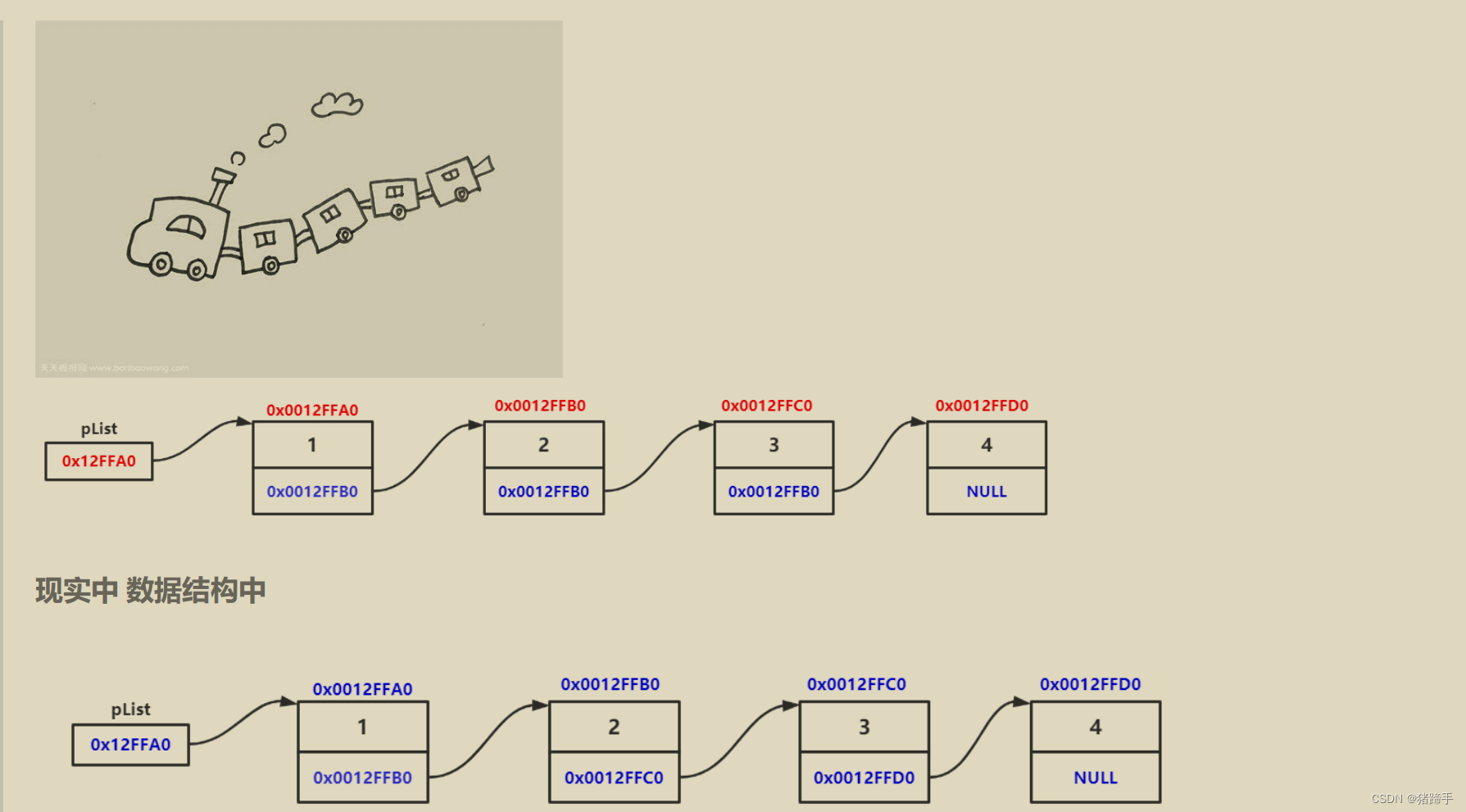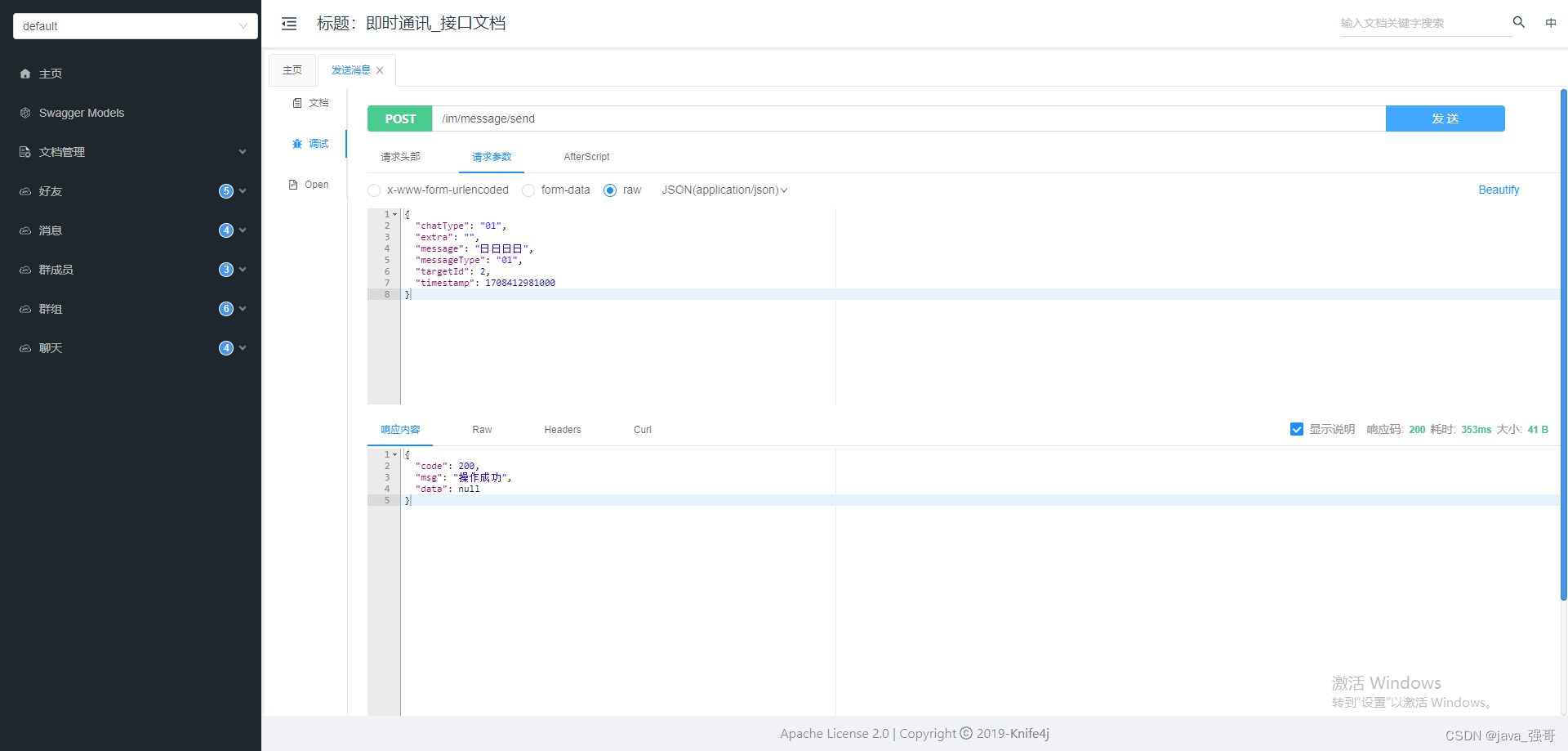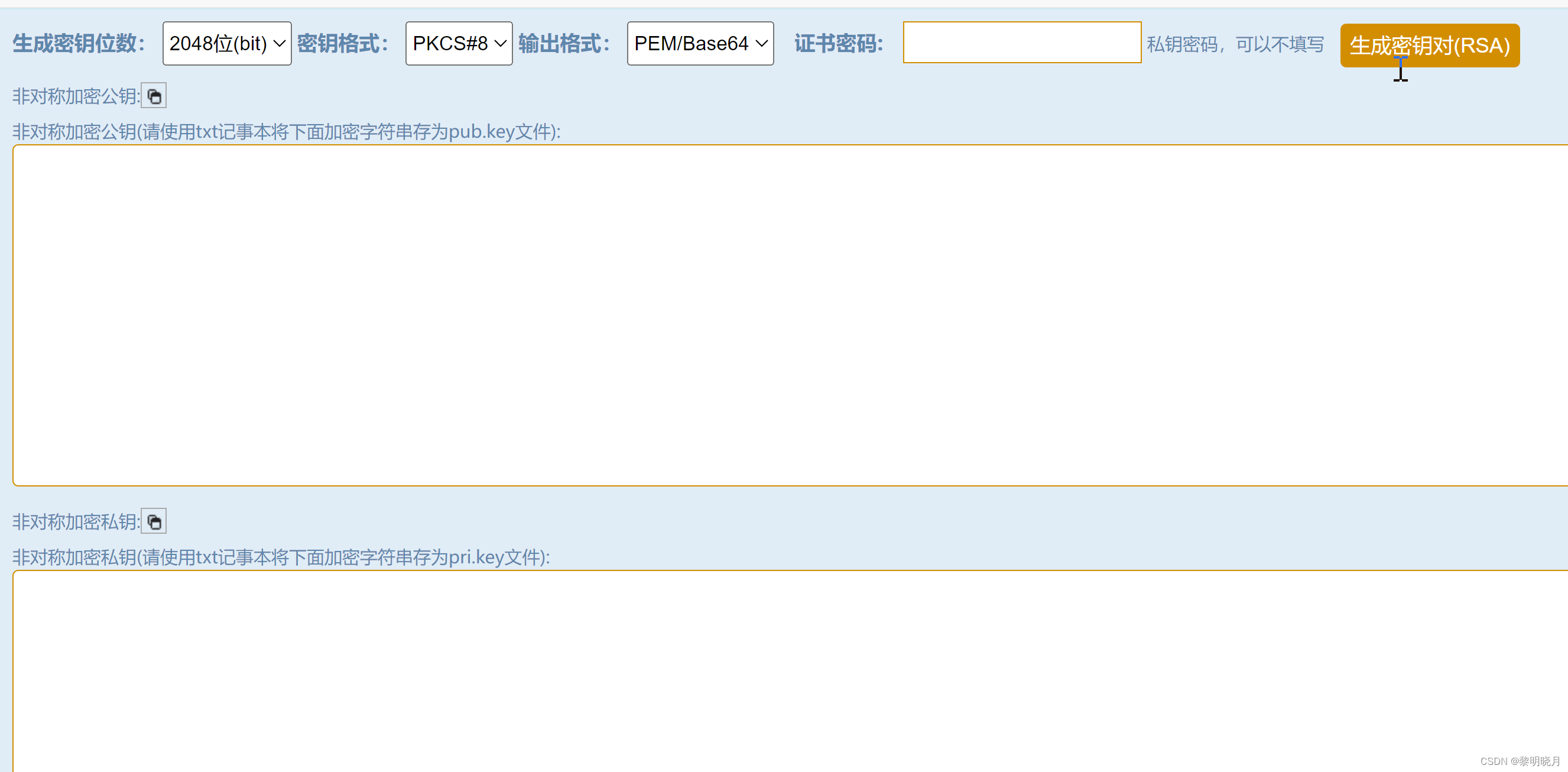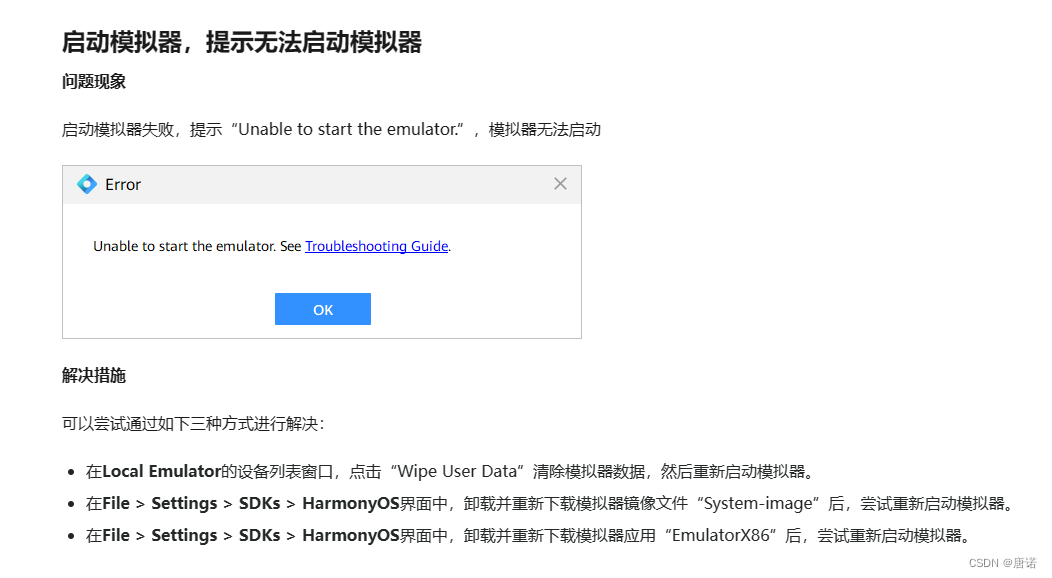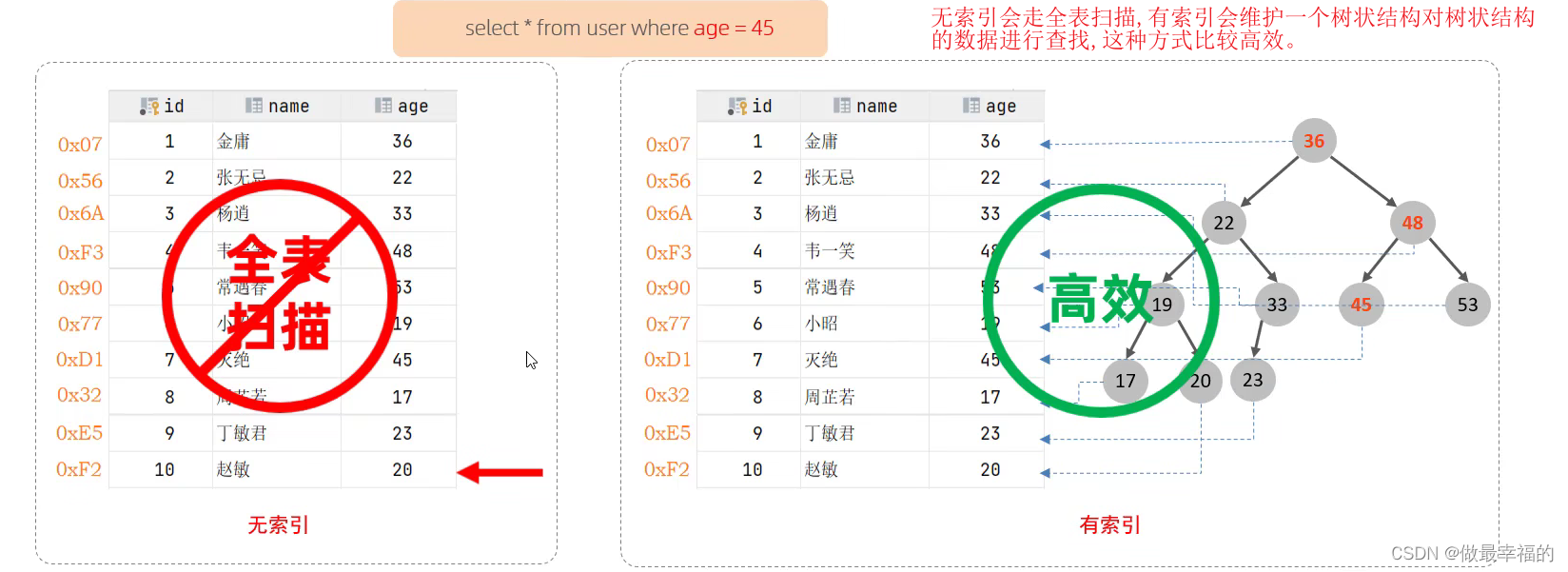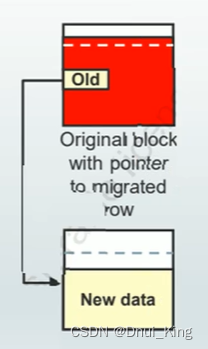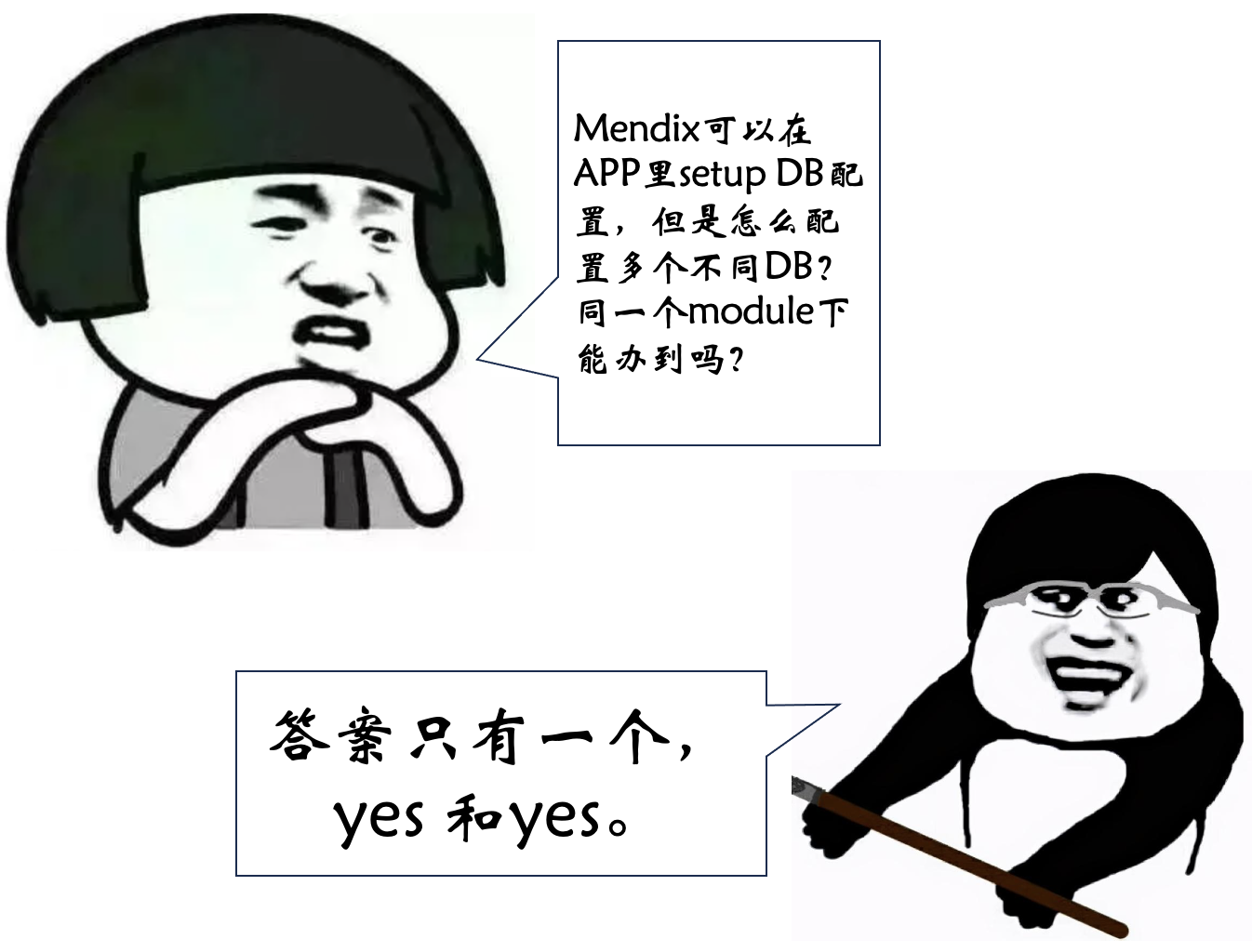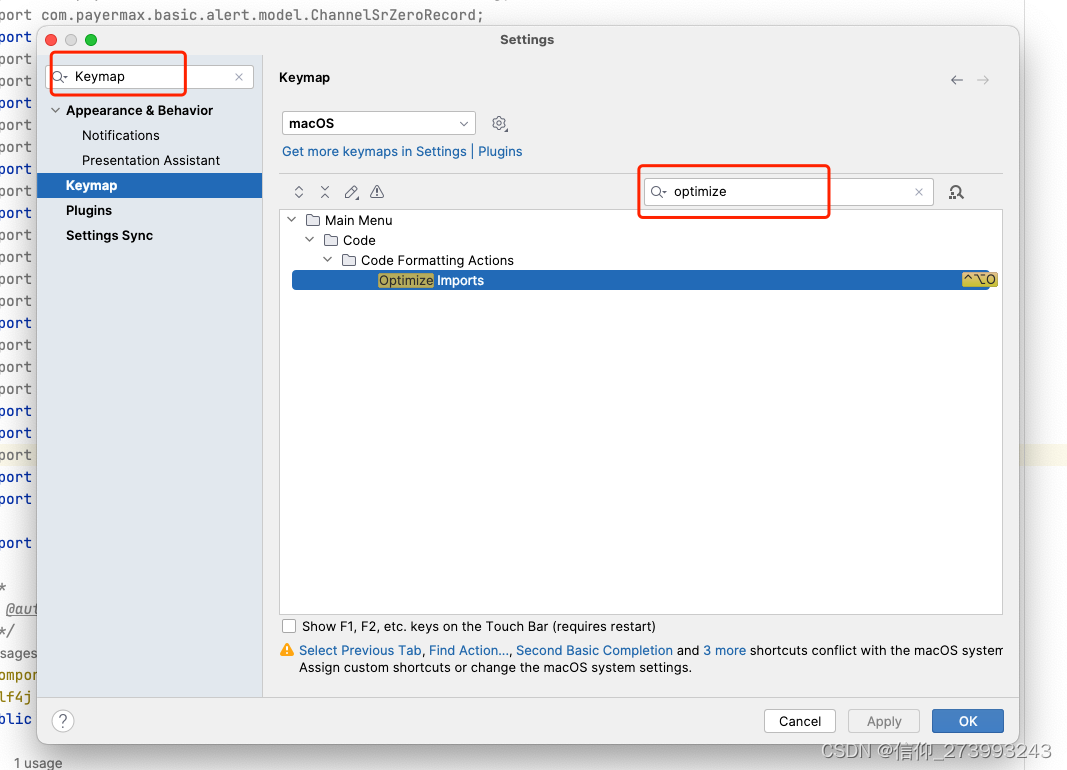单向不带头链表
一、单项不带头链表结构
1.什么是链表?
我的理解是链表是一种逻辑上是线性结构,在真正的内存空间中是非线性,一般而言,不连续的结构,它是通过在堆区一块一块申请空间,用指针把各块空间连起来的结构,也就保存各块空间的地址来连接!!!
下面给出链表的结构!
typedef int SLTDataType;
typedef struct SListNode
{
//存储数据
SLTDataType val;
//存储下一块空间的地址
struct SListNode* next;
}SListNode;
简单认识链表的物理结构!

一个区域存下一个区域的地址,一个区域存数据,这样就用地址把申请的空间链接起来了!
下面实现一下接口:
//申请节点
SListNode* BuySListNode(SLTDataType x);
//打印链表
void SListPrint(SListNode* phead);
//释放节点
void SListDestory(SListNode** pphead);
//尾插
void SListPushBack(SListNode** pphead,SLTDataType x);
//头插
void SListPushFront(SListNode** pphead,SLTDataType x);
//尾删
void SListPopBack(SListNode** pphead);
//头删
void SListPopFront(SListNode** pphead);
//查找节点
SListNode* FindSList(SListNode* phead,SLTDataType x);
//删除指定位置pos
void SListErase(SListNode** pphead,SListNode* pos)
//在pos节点之后插入
void SListInsertAfter(SListNode* pos,SLTDataType x)
//删除pos后面的一个节点
void SListEraseAfrer(SListNode* pos);
下面实现一下这个接口
//先大概写一下测试文件
//Test.c -- 测试文件
#include "SList.h"
void SListTest()
{
SListNode* phead = NULL;
SListPushBack(&phead, 1);
SListPushBack(&phead, 2);
SListPushBack(&phead, 3);
SListPushBack(&phead, 4);
SListPrint(phead);
//SListPushFront(&phead, 4);
//SListPushFront(&phead, 3);
//SListPushFront(&phead, 2);
//SListPushFront(&phead, 1);
//SListPrint(phead);
//SListPopBack(&phead);
//SListPopBack(&phead);
//SListPopBack(&phead);
//SListPopBack(&phead);
//SListPrint(phead);
//SListPopFront(&phead);
//SListPopFront(&phead);
//SListPopFront(&phead);
//SListPopFront(&phead);
//SListPrint(phead);
SListNode* find = SListFind(phead,1);
//SListErase(&phead, find);
//SListPrint(phead);
SListInsertAfter(find,11);
SListPrint(phead);
//SListEraseAfter(find);
//SListPrint(phead);
}
int main()
{
SListTest();
return 0;
}
//尾插怎么写?
//1.考虑没有节点的情况。
//2.考虑有节点的情况。直接插在尾巴后面
void SListPushBack(SListNode** pphead, SLTDataType x)
{
//二级指针不能传null
assert(pphead);
//申请节点
SListNode* newnode = BuySListNode(x);
//1.一个节点问题
if (*pphead == NULL)
{
*pphead = newnode;
}
//2.其它
else {
SListNode* cur = *pphead;
while (cur->next)
{
cur = cur->next;
}
cur->next = newnode;
}
}
//头插怎么写?
//头插有点特殊,不用考虑任何情况,可以直接头插
//因为刚开始SListNode* plist = NULL;刚开始给的是NULL,NULL也是一个地址,所以,申请一个新的节点,可以直接存NULL。
//代码如下
void SListPushFront(SListNode** pphead, SLTDataType x)
{
//二级指针不能传null
assert(pphead);
//申请节点
SListNode* newnode = BuySListNode(x);
newnode->next = (*pphead);
*pphead = newnode;
}
//尾删怎么写?
//要考虑清楚一件事,要正常尾删,必须要能找到前一个节点。因此,考虑只有一个节点和其它节点两种情况!
void SListPopBack(SListNode** pphead)
{
assert(pphead);
//链表不能为NULL
assert(*pphead);
//1.1个节点
if ((*pphead)->next == NULL)
{
free(*pphead);
*pphead = NULL;
}
else{
//2.至少2个节点问题
SListNode* cur = *pphead;
SListNode* prev = NULL;
while (cur->next)
{
prev = cur;
cur = cur->next;
}
//删除节点
prev->next = NULL;
free(cur);
cur = NULL;
}
}
//头删怎么写?
//要考虑头删怎么写,要删除头,把下一个节点存起来,当做newHead,即使下一个节点是NULL,也可以存起来,所以只有一种情况!
void SListPopFront(SListNode** pphead)
{
assert(pphead);
//检测是否有节点
assert(*pphead);
SListNode* next = (*pphead)->next;
free(*pphead);
*pphead = next;
}
//在pos节点之后插入,怎么写?
//可以把pos后面的先存起来,然后在pos之后插入
//或先把节点插在pos之后节点的前面,在把pos里面存新节点
void SListEraseAfter(SListNode* pos)
{
assert(pos);
//assert(pos->next);
if (pos->next == NULL)
{
printf("pos之后的节点为null\n");
return;
}
SListNode* next = pos->next;
SListNode* nnext = pos->next ->next;
pos->next = nnext;
free(next);
next = NULL;
}
//怎样删除pos之后节点?
//1.检测pos之后是不是NULL节点
//2.保存pos后面的后面节点(NULL没有影响),删除pos之后的节点,在链接保存的节点
void SListEraseAfter(SListNode* pos)
{
assert(pos);
//assert(pos->next);
if (pos->next == NULL)
{
printf("pos之后的节点为null\n");
return;
}
SListNode* next = pos->next;
SListNode* nnext = pos->next ->next;
pos->next = nnext;
free(next);
next = NULL;
}
//怎样删除pos节点?
//要删除pos节点,就要找前面和后面(后面的为NULL也可以),但是前面不能没有节点
//因此,考虑pos前面没有节点和有节点
//pos前面没有节点,pos是头,直接头删
//pos前面有节点,正常删除
//删除指定位置
void SListErase(SListNode** pphead,SListNode* pos)
{
assert(pphead);
assert(*pphead);
assert(pos);
//考虑pos前面没有节点
if (*pphead == pos)
{
SListPopFront(pphead);
}
//其它
else {
SListNode* prev = *pphead;
while (prev->next!=pos)
{
prev = prev->next;
}
prev->next = pos->next;
free(pos);
pos = NULL;
}
}
//打印存储的数据
//直接遍历即可
void SListPrint(SListNode* phead)
{
SListNode* cur = phead;
while (cur)
{
printf("->%d", cur->val);
cur = cur->next;
}
printf("->NULL\n");
}
void SListDestory(SListNode** pphead)
{
SListNode* cur = *pphead;
while (cur)
{
SListNode* next = cur->next;
free(cur);
cur = next;
}
*pphead = NULL;
}
完整代码
//SList.h
#pragma once
#include <stdio.h>
#include <assert.h>
#include <stdlib.h>
typedef int SLTDataType;
typedef struct SListNode
{
SLTDataType val;
struct SListNode* next;
}SListNode;
SListNode* BuySListNode(SLTDataType x);
void SListPrint(SListNode* phead);
void SListPushBack(SListNode** pphead, SLTDataType x);
void SListPushFront(SListNode** pphead, SLTDataType x);
void SListPopBack(SListNode** pphead);
void SListPopFront(SListNode** pphead);
SListNode* SListFind(SListNode* phead);
//删除指定指点位置
void SListErase(SListNode** pphead,SListNode* pos);
void SListInsertAfter(SListNode* pos, SLTDataType x);
void SListEraseAfter(SListNode* pos);
void SListDestory(SListNode** pphead);
//sList.c
#include "SList.h"
SListNode* BuySListNode(SLTDataType x)
{
SListNode* newnode = (SListNode*)malloc(sizeof(SListNode));
if (newnode == NULL)
{
perror("BuySListNode malloc fail!");
return 1;
}
//申请成功
newnode->next = NULL;
newnode->val = x;
return newnode;
}
void SListPrint(SListNode* phead)
{
SListNode* cur = phead;
while (cur)
{
printf("->%d", cur->val);
cur = cur->next;
}
printf("->NULL\n");
}
void SListPushBack(SListNode** pphead, SLTDataType x)
{
//二级指针不能传null
assert(pphead);
//申请节点
SListNode* newnode = BuySListNode(x);
//1.一个节点问题
if (*pphead == NULL)
{
*pphead = newnode;
}
//2.其它
else {
SListNode* cur = *pphead;
while (cur->next)
{
cur = cur->next;
}
cur->next = newnode;
}
}
void SListPushFront(SListNode** pphead, SLTDataType x)
{
//二级指针不能传null
assert(pphead);
//申请节点
SListNode* newnode = BuySListNode(x);
newnode->next = (*pphead);
*pphead = newnode;
}
void SListPopBack(SListNode** pphead)
{
assert(pphead);
//链表不能为NULL
assert(*pphead);
//1.1个节点
if ((*pphead)->next == NULL)
{
free(*pphead);
*pphead = NULL;
}
else{
//2.至少2个节点问题
SListNode* cur = *pphead;
SListNode* prev = NULL;
while (cur->next)
{
prev = cur;
cur = cur->next;
}
//删除节点
prev->next = NULL;
free(cur);
cur = NULL;
}
}
void SListPopFront(SListNode** pphead)
{
assert(pphead);
//检测是否有节点
assert(*pphead);
SListNode* next = (*pphead)->next;
free(*pphead);
*pphead = next;
}
SListNode* SListFind(SListNode* phead,SLTDataType x)
{
//不能为NULL
assert(phead);
SListNode* cur = phead;
while (cur)
{
if (cur->val == x)
{
return cur;
}
cur = cur->next;
}
//找不到,为NULL
return NULL;
}
void SListInsertAfter(SListNode* pos, SLTDataType x)
{
assert(pos);
//申请节点
SListNode* newnode = BuySListNode(x);
SListNode* next = pos->next;
pos->next = newnode;
newnode->next = next;
}
void SListEraseAfter(SListNode* pos)
{
assert(pos);
//assert(pos->next);
if (pos->next == NULL)
{
printf("pos之后的节点为null\n");
return;
}
SListNode* next = pos->next;
SListNode* nnext = pos->next ->next;
pos->next = nnext;
free(next);
next = NULL;
}
//删除指定位置
void SListErase(SListNode** pphead,SListNode* pos)
{
assert(pphead);
assert(*pphead);
assert(pos);
//考虑pos前面没有节点
if (*pphead == pos)
{
SListPopFront(pphead);
}
//其它
else {
SListNode* prev = *pphead;
while (prev->next!=pos)
{
prev = prev->next;
}
prev->next = pos->next;
free(pos);
pos = NULL;
}
}
void SListDestory(SListNode** pphead)
{
SListNode* cur = *pphead;
while (cur)
{
SListNode* next = cur->next;
free(cur);
cur = next;
}
*pphead = NULL;
}
//测试代码
#include "SList.h"
void SListTest()
{
SListNode* phead = NULL;
SListPushBack(&phead, 1);
SListPushBack(&phead, 2);
SListPushBack(&phead, 3);
SListPushBack(&phead, 4);
SListPrint(phead);
//SListPushFront(&phead, 4);
//SListPushFront(&phead, 3);
//SListPushFront(&phead, 2);
//SListPushFront(&phead, 1);
//SListPrint(phead);
//SListPopBack(&phead);
//SListPopBack(&phead);
//SListPopBack(&phead);
//SListPopBack(&phead);
//SListPrint(phead);
//SListPopFront(&phead);
//SListPopFront(&phead);
//SListPopFront(&phead);
//SListPopFront(&phead);
//SListPrint(phead);
SListNode* find = SListFind(phead,1);
//SListErase(&phead, find);
//SListPrint(phead);
SListInsertAfter(find,11);
SListPrint(phead);
//SListEraseAfter(find);
//SListPrint(phead);
SListDestory(&phead);
}
int main()
{
SListTest();
return 0;
}
完结!!!

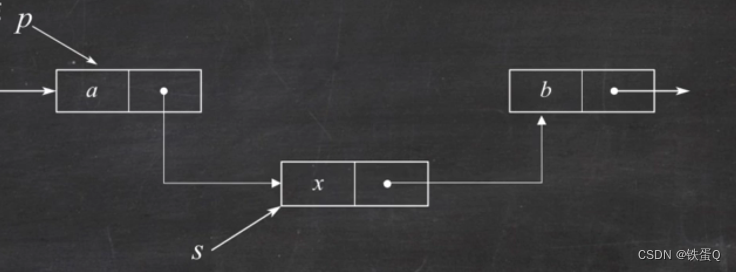

![[数据结构]<span style='color:red;'>不</span><span style='color:red;'>带头</span><span style='color:red;'>单向</span>非循环<span style='color:red;'>链</span><span style='color:red;'>表</span>](https://img-blog.csdnimg.cn/direct/ded8719e310d491f912e5ac8e02551eb.png)

